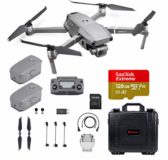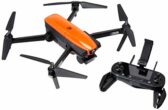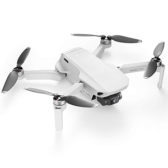The Best Long Range Drones: Operating From A Distance
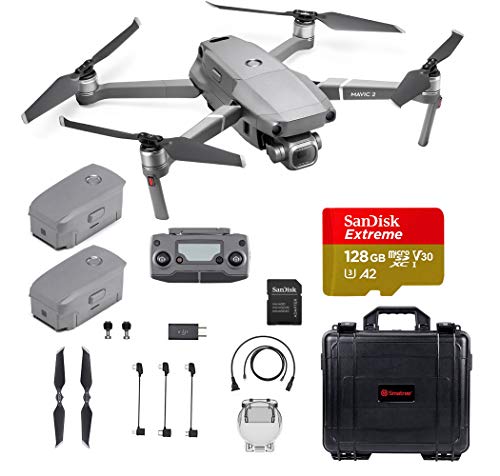
DJI Mavic 2 Pro
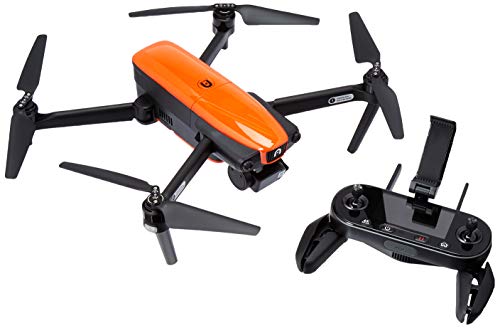
Autel Robotics EVO
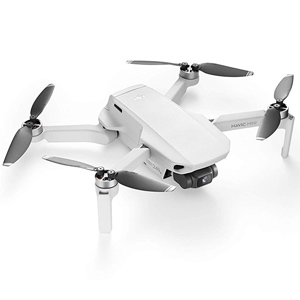
DJI Mavic Mini
Whenever people buy a drone, they usually go through the standard set of specs.
Things like flight time, camera quality, and top speed.
But there’s one thing that many people tend to miss out on:
Range.
You won’t see many people getting a drone solely because of its range, and we don’t tend to do this as well. But that doesn’t mean it’s not an important consideration. In fact, it will have an impact on how capable your drone is.
Yet the real reason people don’t worry about the range that much is that they simply don’t know what it is!
So let’s demystify that a bit. We’ll delve deep into a drone’s range, and then give you our recommendations on the best drones that have the most extended range in the market.
First, though, we have to understand how drones transmit data.
How Does Drone Transmission Work?
All drones, even the most autonomous ones, need to receive commands from an external source. They need this so they would know what to do.
In most cases, this is transmitted from a remote controller being held by the pilot. A drone then needs to be able to receive this data wirelessly.
Data transmission between remote and drone is done through radio waves. These are electromagnetic signals which carry with them electric information, much like how radio stations send signals to your car stereo to produce music.
Drones make use of these radio signals to produce movement. Radio frequencies are measured in hertz (Hz).
To control a drone using radio waves, you need a remote controller. You usually direct your drone’s movement through the use of joysticks. The traditional ones (think RC controllers) operate in the 900 MHz spectrum. Nowadays, you can also use your smartphone to control a drone, using Wifi. Wifi is just another form of radio wave, operating at a broader 2.4 GHz range.
So here’s how it all works. Whenever you press a button or tilt the joystick on your controller, corresponding radio waves are sent by the controller’s transmitter, or Tx, unit. This then reaches your drone, which has to receive and interpret these signals somehow.
This is the job of the receiver, or RX unit, on the drone. These are devices with a built-in antenna to capture radio signals from your controller. It’s also responsible for converting radio waves into electrical signals, which send it to your drone’s flight controller.
The flight controller then is the one responsible for interpreting these signals to direct the computer board, motors, and propellers. These, in turn, are the ones who ultimately produce the drone’s movement.
You can think of drones as having an invisible cable between it and the remote controller. The stronger this link, the greater the distance possible between drone and controller. A better link also makes it possible to transmit more substantial data, such as live video feeds.
What Is The Average Drone Range?
Now that we know how a drone’s transmission works, we can define what drone range is.
Simply put, it’s how far the drone can fly away from you.
This seemingly simple definition, however, has some implications on your drone’s performance.
The longer the drone’s range, the stronger the signal. Therefore, in shorter distances (which is how you’ll be flying the drone most of the time), the better the transmitter can resist interference. Thus, you can better control the drone without the risk of losing the signal.
Of course, the real perk of a long range drone is being able to reach impossible heights and distances. With a top-notch long distance drone, you’ll be able to go farther and fly higher. You’ll have plenty of room to be able to shoot some genuinely spectacular sequences.
Imagine being able to fly and shoot through canyons and ravines, or maybe a vast, majestic panorama from really high up. For the professional videographer or photographer, this is a must-have for producing unique, breathtaking, and majestic photos and videos.
Long range drones are also indispensable for scientific and industrial applications like surveying and data measurement. Most of these applications require flying into dangerous heights or areas that would be hazardous to humans.
Of course, not everyone needs this feature. Not everyone is a pro who wants to fly their drones miles away from them. Flying them that far out also puts the drone at a higher risk of losing its signal and accidentally crashing.
That’s why most drones nowadays have an average range of about 1.5 km, operating at a 2.4 GHz frequency. This is applicable for most mid-to-high-priced drones and represents a good balance between range and price for most enthusiasts (price tends to go up as the flight distance increases).
Budget drones have a range of less than 1 km, usually around 500m to 800m at best. That’s perfect for beginners – after all, they shouldn’t even fly that far out when they’re just learning the ropes. Plus, they’re cheaper.
Still, it’s beneficial to buy the cheapest drone with the most extended range you can afford if you’re a beginner. This will ensure you have robust signal strength during normal flight conditions.
At the higher end of the spectrum, you have high-end drones, which tends to have really long ranges. Here, there tends to be a bit of variety, with average distances of about 5 km. The longest we’ve seen is 8 km, which is really pushing the boundary of how long ranges can be for consumer drones.
What to Look For In A Long Range Drone
If you plan on flying your drone at extreme distances, you need to consider a few things. The reason is that long range flying creates particular problems that need to be resolved.
The most obvious, of course, is that you’ll likely can’t see your drone directly anymore. For instance, at 5 km out or more, the drone is most likely already outside of your line of sight, making it challenging to control.
Hence, you need another way to see where the drone is going.
Another thing is that the father the drone is away from you, the higher the risk of it losing connection with your remote controller. Once it loses its signal, what happens with the drone? There are quite a few reports of UAVs going “rogue” and just flying off indefinitely into the horizon once they lose their signal.
You’ll eventually notice that a lot of the considerations when buying long range drones are mostly safety features designed to protect your drone in case it goes out of range.
So, let’s go to what makes a good long range drone.
Effective Range
The no-brainer spec is, of course, drone range. This is how far a drone can fly form you under ideal conditions. Do take note of those last two words – ideal conditions.
This means that you can fly 8 km out only when the stars align, the weather is perfect, and there’s not much interference and obstacles. This is, of course, wishful thinking; it’s not always possible.
There are a lot of other factors that can negatively affect the range and possibly shorten it. Things like battery life and the weather conditions at the time all play a significant role. The presence of obstacles and being in an area with high interference, will also weaken the signal and shorten the drone’s effective range.
That’s why it’s recommended that you never fly anywhere near the maximum range. Always factor in a little bit of buffer in case conditions isn’t favorable. If you ever need to go close to the max range, do it slowly.
FPV (First Person View) Mode
The drone’s range is just a small part of the long-range picture. Once it’s out there flying, you’ll need a reliable way to see where it is going so you can steer it properly. Without it, you’re mostly flying blind.
This is where First Person View (FPV) Mode comes in.
Here, the drone sends a live transmission of what it “sees” using its built-in video camera. This is streamed to your remote controller’s screen or through your smartphone mounted on your controller. Some systems even support viewing FPV mode via a VR headset, giving you a really immersive experience.
Now, the most crucial factor when picking a good FPV feature is that the video must be in real-time, or somewhere very close to it. Lags are catastrophic – a split second delay in a live feed can cause you to react much slower, potentially causing crashes.
As you can imagine, streaming video is much, much demanding than transmitting simple drone commands. Hence, the drone’s FPV range is even shorter than the drone’s range. This effectively further shortens the max distance you can safely go.
That’s why we recommend getting a drone with high FPV transmission frequencies, like a 5.8 GHz or dual 2.4 GHz systems. Both are robust enough to provide reliable streaming.
GPS
If you’re to fly out your drone far away, you need a way for it to be aware of where it is and its surroundings. This is done using an onboard GPS system.
By connecting to GPS satellites, both you and your drone will know precisely where it is at any given time. This lessens the chance of your drone getting lost. Plus, if the worse were to happen and it does disappear or crashes, you’d know where to find it.
GPS is also used by the drone in more advanced flight modes like Waypoint or Points of Interest. These are useful for orchestrating complex shots easily and intuitively, at long distances.
GPS also powers a vital safety feature, in the form of…
Auto Return
When you’re flying long range and pushing your drone to how far it can go, you risk the signal getting cut. And when the drone loses its connection to your remote controller, it could crash or wander off forever.
That’s why you need a safety net to make sure nothing happens to your drone in such a situation. One of the most common is Auto Return, a feature that DJI pioneered.
Also called Return To Home (RTH) in some drones, this instructs your drone to go back to its takeoff point whenever certain conditions are met. Using GPS, it will keep track of where it took off, and automatically fly there to land when certain conditions are met.
The usual condition is when its battery reaches critical levels. It will then use its remaining battery power to fly back and land in its origin point. But this can also be set to trigger when the signal is lost, so you’ll be sure the drone comes back to you.
Flight Time
A long range needs to be paired with equally long flight time. After all, it needs all the power it needs to fly all that extra distance and come back in one piece. The longer the distance you want it to fly, the more time it needs to stay afloat.
For drone ranges of more than 5 km, a flight time of 25 minutes or longer is essential. Anything less might put the drone at risk of losing power before it can return to you.
But even if you have the best flight time and range, you still have to be cautious. Remember that these specs all assume ideal conditions, and a lot of factors will lessen that considerably.
A good rule of thumb is that you don’t want to push both drone range and flight time together; i.e., don’t fly out at extreme distances for maximum flight times. That is just putting a lot of risks at the same time.
Obstacle Avoidance
When you’re out at very long distances, you need all the safety features you can get, especially if you have limited visibility of your drone. Even with FPV, it won’t give you a 360-degree view of all the dangers your drone might encounter.
That’s why Obstacle Avoidance System is a must-have. This enables the drone to automatically detect any obstacle in its flight path or around it, thereby preventing a crash. It then either avoids it or stops entirely and waits for further command, depending on the drone.
A lot of drones have forward obstacle avoidance sensors, but quite a number will have side sensors as well. For long-distance flight, we recommend getting full 360 sensors if you need to.
Camera Quality
What’s the entire point of flying out to really extreme distances? For the average consumer, it’s to take really awesome photos. So if you’re capturing that unique perspective using a subpar camera, it hardly seems worth the effort, doesn’t it?
That’s why it’s vital to get a drone with incredible camera quality. It will allow you to take those breathtaking photos and videos.
For footage, we recommend getting cameras with 4K resolutions. Gimbals are vital for image stabilization, as it’s difficult to achieve professional, jittery-free shots without it. For photos, anything above 12 megapixels will produce stunning results.
Best Long Range Drones
We’ve listed the best drones from the most extended range first, starting with:
We may receive compensation on qualifying purchases via our links. This does not change how we review items. For more information, please read our affiliate disclosure.
This luxury drone is one of the best in the market and comes with a 4-figure price tag.

- Flight Time: 30 minutes
- Range: 7 kilometers
- Camera: 4K resolution at 30 fps; 20 MP stills
- Weight: 1.64 pounds
- Gimbal: 3 Axis
The title of the drone with the longest range goes to the DJI Mavic 2 with a maximum transmission distance of 8 km.
That’s ridiculously long if you consider the average drone only gets to about 1.5 km! Indeed, few consumer drones outside DJI can match that. To complement that long range, the Mavic 2 also has one of the longest flight times as well, at 31 minutes.
In short, you’re looking at the ultimate long range, endurance consumer flying machine. The Mavic 2 Pro allows you to do really spectacular shots and majestic flybys not possible with any other drone in the market.
Even at the worst conditions and transmission range is severely compromised, you’re looking at a distance of around 4 – 5 km; that’s still at the upper tier when it comes to drone range. At standard flying distances, losing signal strength is next to impossible.
And to further improve signal quality, it has a Real-Time Auto-Switching feature. It allows the Mavic 2 to change between 2.4 GHz and 5.8 GHz frequencies. This is because the 2.4 GHz is the same one used by a lot of wireless devices, creating a lot of interference. Auto-switching enables the drone to get the clearest signal possible.
At 5 – 8 km ranges, however, FPV becomes a necessity. Fortunately, the Mavic 2’s OccuSync 2.0 transmission system also makes it possible to stream high quality 1080p HD live feed video at the same max distance of 8 km. Amazingly, there are no lag or latency issues whatsoever.
The Mavic 2 also comes with a powerful omnidirectional obstacle sensing system. This is one of the few drones in the market that can avoid obstacles in all directions, an essential feature for super long range flights.
Of course, safety mainstays like Auto Return are there. Overall, it makes for a more safe long range flight experience. The included DJI Smart Controller also makes it incredibly easy to control the drone even when you can’t see it.
Of course, the whole point of long range flight is taking the best photos and videos possible, and that’s where the Mavic 2 shines bright.
The Mavic 2 Pro version has the upper hand in this, with a powerful Hasselblad L1D-20c 20MP / 4K UHD camera with 1 inch CMOS sensor. The Mavic 2 Zoom version has a less clear camera but can do 2x optical zoom.
When it comes to achieving “impossible” long range photos, the Mavic 2 is the gold standard. It is, by far, the absolute best consumer drone you can buy today if the price is no issue.
+ Pros
A 4K drone with a 12MP camera that folds up for handy portability. It’s water-resistant, too!

- Flight Time: ~30 minutes
- Charge Time: ~210 minutes
- Range: 7050m / 4.4 miles
- Remote Controller: WiFi 2.4GHz (included in the set)
- Camera: 3-axis gimbal 4K 60fps camera with 12MP
- Live Video Transmission Range: 7000m / 4.3 miles
- Weight: 863g / 1.9lbs
- Carry Capacity: N/A
- Working Temperature: 0°C ~ 40°C
- Rated for outdoor use
The Autel EVO is one of the more advanced drones in the market. Yet it’s a rugged little flyer that can withstand strong winds and the occasional rain – certainly a good trait for any long range drone to have.
The EVO possesses one of the longest ranges in a consumer drone – 7 km at ideal conditions. Amazingly, this distance also covers a smooth live 720p HD FPV video, streamed directly to the Autel Explorer app on your smartphone.
Working together with the range is this drone’s battery capacity. It allows the EVO to stay afloat for up to 30 minutes, even with not-so-ideal weather conditions. Personally, the minimum we had from this drone was 25 minutes.
This stellar combination of transmission and battery power means you can really push the EVO further and farther than most drones can handle.
And to help makes long range flights safer, the EVO is equipped with lots of intelligent and safety features. Failsafe is the most basic and alerts you if the battery is critical, and it’s time for the drone to land.
Just in case you can’t land it, or if the EVO goes out of control range, then the Go Home feature will allow the drone to go back to its takeoff point automatically. In case there’s no GPS signal, then it will hover in place using its Starpoint Positioning feature.
The EVO also has an advanced obstacle avoidance system. It’s capable of analyzing obstacles in front of it via the camera and knows when it is approaching one. When it does, it automatically stops. It also has rear sensors that detect heat and movement on the sides of the EVO.
Camera performance is also top-notch. The EVO has a powerful 4K camera, 3-axis gimbal, and Ambarella H2 image processors for awesome looking, jitter-free long range footage.
Overall, the Autel EVO has a lot going on for it. The extreme range and safety features make this a long range flying machine, at a price tag that’s not as expensive as a comparable DJI model.
+ Pros
- Cons
The Mavic Mini has replaced the hugely popular Spark model and will become one of the most popular drones of all time.

- Flight Time: ~28 minutes
- Charge Time: ~90 minutes
- Range: 3000m / 9842ft
- Remote Controller: WiFi 5.4GHz & 2.4Ghz (included in the set)
- Camera: 3-axis gimbal 2K Camera with 12MP
- Live Video Transmission Range: 2500m / 8200ft
- Weight: 249g / 8.78oz
- Working Temperature: 0°C ~ 40°C
- Rated for indoor and outdoor use
It shouldn’t be surprising to see more than one DJI drone in this list. This is partly because they have the most extreme ranges across their entire lineup, even with their starter drones.
Case in point is their entry-level offering, the Mavic Mini, one of DJI’s smallest and more affordable drones. It weighs only a paltry 249g and is no bigger or heavier than your average smartphone.
But don’t let the size fool you. It does inherit some of the power and features of the other drones in the Mavic series.
The Mavic Mini is capable of a maximum transmission distance of 4 km. That’s pretty amazing for a starter drone, considering others in its category usually registers at only 500 meters or less at best.
For beginners, this can actually be a dangerous thing, as they can get carried away and fly it out further than they’re supposed to. Fortunately, the Mavic Mini has safety features built-in to help mitigate any risk on your drone.
Examples include the automatic Return to Home feature in case it loses either battery power or transmission signal. And while it doesn’t have an obstacle avoidance system, it does have a durable 360 propeller guard to help soften the blow in case it crashes.
The 4 km max range also happens to be the maximum distance of the HD video transmission. This means you can get into FPV mode with a smooth, lag-free feed. Ultimately, this means you can maneuver the drone at long distances better.
The 30 minute flight time of the Mavic Mini also helps you achieve flying safely at longer distances. Yup, that’s 30 minutes of flight time for a beginner, who usually only sees about 5-10 minutes of action in other drones.
For taking those long distance photos and vides, the Mavic Mini has a 2.7K / 12 MP camera on board, with a 3-axis gimbal for more stability. For a beginner, the image quality is a real treat that even pros will appreciate it.
So all in all, the Mavic Mini is a surprisingly powerful long range drone in a tiny package. It’s something both beginners and pros will happily own.
+ Pros
- Cons
GPS, 4K video and a staggering 21 MP camera allows for some of the most beautiful drone shots imaginable.
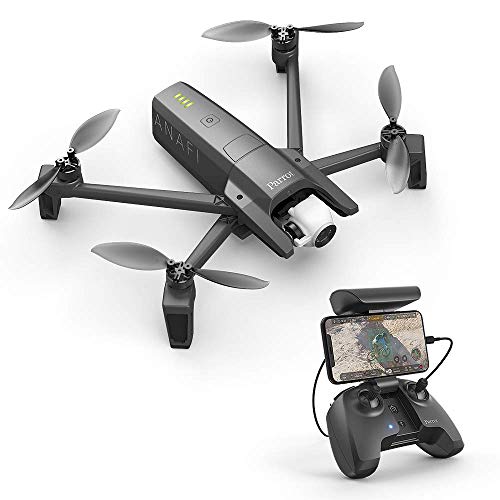
- Flight Time: ~25 minutes
- Charge Time: ~240 minutes
- Range: 4000m / 2.5mi
- Remote Controller: WiFi 5.4GHz & 2.4Ghz (included in the set)
- Camera: 180° adjustable f/2.4 ASPH lens 4K Camera with 21MP
- Live Video Transmission Range: 4000m / 2.5mi
- Weight: 320g / 11.28oz
- Working Temperature: -10°C to 40°C
- Rated for indoor and outdoor use
Long distance drones are usually the domain of DJI, with some notable exceptions. One of them is the Parrot Anafi, a compact, foldable consumer drone that means business.
As far as endurance goes, the Anafi can keep up with a DJI. It sports Parrot’s powerful transmission system, with each leg of the drone containing a dual-band antenna. The combined 2.4 GHz and 5 GHz frequencies give the Anafi superb signal strength.
In practice, this makes the Anafi capable of flying up to 4 km away. FPV is also smooth thanks to the lag-free HD video transmission directly to your smartphone via the FreeFlight 6 app. This is mounted on the Parrot’s intuitive Skycontroler 3 remote controller, allowing complete control during long range flights.
The Anafi also has a proprietary intelligent LiPO battery, giving the drone a lengthy flight time of 25 minutes. Combined with charging that’s 60% faster, it allows plenty of buffer room for you to maximize the drone’s long range.
Long distance flying can be risky to your drone, so the Anafi has plenty of insurance built-in to make it safer.
Smart RTH (Return to Home) is your go-to safety feature. Whenever the Anafi loses its connection to your Skycontroller or loses battery power, it will automatically fly to its takeoff point by default. This lessens the risk of the drone crashing or wandering off indefinitely.
You can also make use of Geofence, which sets a virtual boundary that safely contains the Anafi to a specific area. And in the off chance that you can’t find your drone, the Find My Drone feature can help you find it via the map on your smartphone app.
The Anafi’s camera shoots at an impressive 4K / 21 MP resolution, allowing you to achieve fantastic aerial shots. In addition, the 3-axis gimbal can make video footage smooth and stable.
Overall, the Parrot Anafi is an excellent alternative to a long range DJI drone. It’s capable of long transmission ranges of 4 km with crisp and smooth HD FPV. It’s a distance that already works well for a lot of casual and pro users.
+ Pros
- Cons
A fast, affordable drone with decent battery life, capable of recording 2K video footage.
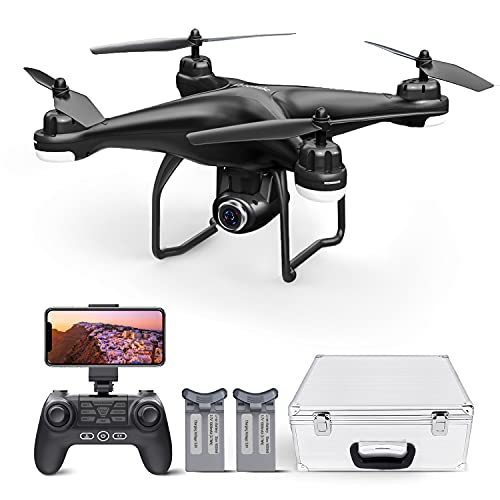
- Flight Time: 20 minutes
- Range: Up to 1500 metres
- Camera Resolution: 1080p HD
- Weight: 525g
When it comes to feature-packed drones with an attractive price, the Potensic D85 is one of the better choices. For a mid-priced drone, it has a pretty decent range, flying outwards up to a maximum of 1.5 km.
It’s not that long of a range compared to the others on this list, but for casual users, it’s more than enough. The real benefit of this is that it gives the D85 a robust signal strength, reducing the chances of you losing control at less than ideal situations.
Plus, the D85 more than makes up for the lack of extra range with its other features. In fact, the D85 is a multi-purpose drone. It has a decent 2K camera that you can detach, then it becomes a recreational drone. And since it can fly at a speed of up to 50 km/h, it’s more than capable of being a racing drone.
The D85 also supports FPV with real-time video transmission to your smartphone. The wide-angle 130-degree FOV gives you a broader view in front of the drone, which makes flying in FPV easier.
FPV mode also uses 5G Wi-Fi instead of the usual 2.4 GHz signal, giving it better and smoother performance. There’s also less interference in the 5G frequency than in 2.4 GHz.
For a drone with a medium range, the D85 has basic safety figured out. The Auto Return feature allows the drone to return to its origin point automatically. This is triggered when the drone goes beyond range and loses control, but also when the battery reaches critical levels.
In the end, the price of the Potensic D85 is what brings it home. You get a decent multi-role drone with excellent features and the basics covered for a safe, mid-ranged flight.
+ Pros
- Cons
No products found.
4K video, 12MP photos and 25-minute battery life for stunning aerial shots.
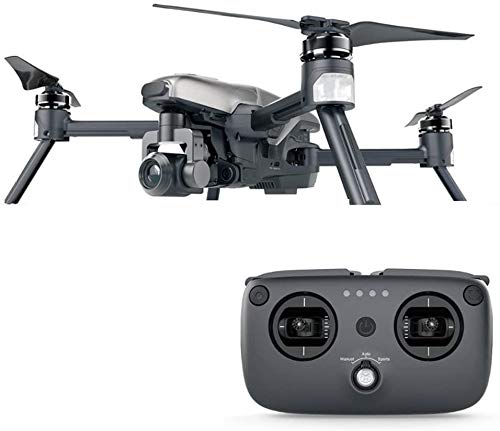
- Flight Time: 28 minutes
- Camera Resolution: 4K UHD
- Sensor Size: 1/2.3 inch CMOS
- Frame Rate: 30 fps and 60 fps
- Gimbal: 3-axis with 90-degree adjustable angle
- Weight: 890g
The Walkera Vitus 320 is a mid-range, excellent photography drone. This is thanks in part to the 12-megapixel camera and 1/2.3 inch Sony CMOS sensor it has installed.
When it comes to the transmission distance, the Vitus 320 has a maximum range of 1.5 km. Not as lengthy as the other powerhouses we’ve seen in this review, but impressive enough on its own. 1.5 km can, in fact, already get you some pretty amazing looking photos
This is more so when you in factor in the 25 minutes of flight time the Vitus 320 can give you. You can pretty much cover its entire 1.5 km range multiple times with that!
Safety is also rock solid with the Vitus 320. The drone is equipped with a GPS/GLONASS combo that makes for more precise positioning. It powers the all-important GPS Return feature, making the Vitus 320 return automatically when signal or power is cut off.
Adding to the Vitus 320’s safe operation is its 3-way Obstacle Avoidance System. With its onboard infrared sensors and optical flow camera, it’s much competent at avoiding collisions and obstacles.
In the end, the Walkera Vitus 320 is an excellent alternative for a photography drone with mid-range capabilities.
+ Pros
- Cons
No products found.

